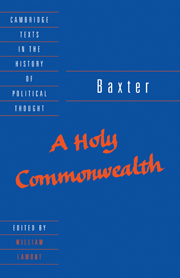Book contents
- Frontmatter
- Contents
- Preface
- Introduction
- Richard Baxter: a chronology
- Further reading
- Biographical notes
- A Holy Commonwealth
- Preface
- An Addition to the Preface
- Adam Contzen the Jesuites Directions
- 1 There is a God that is mans Creator
- 2 God is the Soveraign Ruler of Mankind
- 3 Of the Constitution of Gods Kingdome
- 4 Of the Administration of the Universal Kingdom
- 5 Of a subordinate Commonwealth in General
- 6 Of the several sorts of Commonwealths
- 7 Of the Foundation efficient and conveying causes of Power
- 8 Of the best form of Government, and Happyest Common-wealth
- 9 How a Commonwealth may be reduced to this Theocratical temper, if it have advantages, and the Rulers and People are willing
- 10 Of the Soveraigns Power over the Pastors of the Church, and of the difference of their Offices
- 11 Of the Soveraigns Prerogatives, and Power of Governing by Laws and Judgement
- 12 Of due Obedience to Rulers, and of Resistance
- 13 Of the late Warres Meditations
- Appendix: Preface to The Life of Faith (1670)
- Index
- Title in the Series
1 - There is a God that is mans Creator
Published online by Cambridge University Press: 05 June 2012
- Frontmatter
- Contents
- Preface
- Introduction
- Richard Baxter: a chronology
- Further reading
- Biographical notes
- A Holy Commonwealth
- Preface
- An Addition to the Preface
- Adam Contzen the Jesuites Directions
- 1 There is a God that is mans Creator
- 2 God is the Soveraign Ruler of Mankind
- 3 Of the Constitution of Gods Kingdome
- 4 Of the Administration of the Universal Kingdom
- 5 Of a subordinate Commonwealth in General
- 6 Of the several sorts of Commonwealths
- 7 Of the Foundation efficient and conveying causes of Power
- 8 Of the best form of Government, and Happyest Common-wealth
- 9 How a Commonwealth may be reduced to this Theocratical temper, if it have advantages, and the Rulers and People are willing
- 10 Of the Soveraigns Power over the Pastors of the Church, and of the difference of their Offices
- 11 Of the Soveraigns Prerogatives, and Power of Governing by Laws and Judgement
- 12 Of due Obedience to Rulers, and of Resistance
- 13 Of the late Warres Meditations
- Appendix: Preface to The Life of Faith (1670)
- Index
- Title in the Series
Summary
Thes. 1. There are men inhabiting the earth.
He that denyeth this, denyeth himself to be a man, and therefore is not to be disputed with yet proveth it to others, while he denyeth it.
Thes. 2. Man is not Eternal; but had a beginning.
We see it of all the Individuals, that they by Generation receive their Existence; There is no man alive now here in flesh, that was alive a thousand years ago. Generation succeedeth Generation. And as all men that are now on earth had a Beginning, so must there be one first man that also had a Beginning. Or else he must have been a pure Act, without Composition, or imperfection, self-sufficient, and without cause, and so not have been Man but God, and therefore not the supposite that we speak of: And as he had been infinite in Duration on a part ante, so must he be a parte post: for that which have no cause, can have dissolution or end. But this is not the case of man: therefore man had a Beginning.
Thes. 3. Man did not make himself.
For before he was, he was not: and that which is not, cannot work. Nothing can do nothing: whosoever made him, knew what he did, and how, and why. But neither he that was not, nor his parents knew either what was doing while he was formed in the womb, and how he was fashioned, nor to what end each part and motion was appointed. Therefore neither did we make ourselves.
- Type
- Chapter
- Information
- Baxter: A Holy Commonwealth , pp. 51 - 53Publisher: Cambridge University PressPrint publication year: 1994



